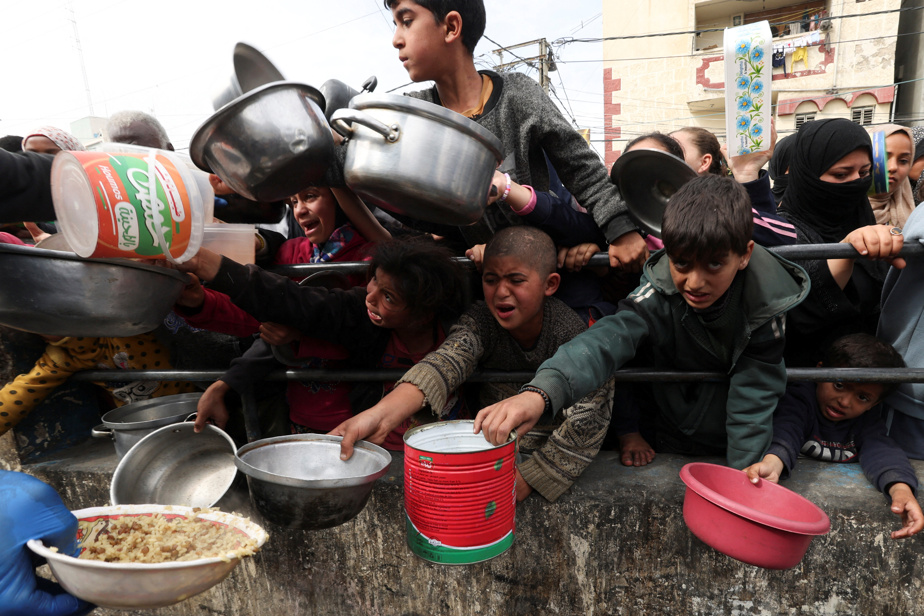Why this new round of talks?
Since the Hamas attack in Israel on October 7, in which more than 1,200 people were killed, according to official Israeli figures, and 250 were taken hostage and brought to the Gaza Strip, the war has seen only one truce, in November. It allowed the release of around a hundred hostages and 240 Palestinian prisoners held in Israel, in addition to a humanitarian respite.
The situation is deteriorating in the Gaza Strip, where more than 28,000 people have been killed, according to the Gaza Health Ministry. Its residents are at imminent risk of famine, according to the UN Office for the Coordination of Humanitarian Affairs (OCHA).
The families of the Israeli hostages, for their part, despair of seeing their loved ones again. Testimonies of mistreatment and sexual assault confirm their fears.
This week, Israeli Prime Minister Benjamin Netanyahu ordered the preparation of an offensive in Rafah, where more than 1.4 million people are crowded together. The UN was concerned about a possible “massacre” if it actually took place.
On Tuesday, Egyptian leaders met with American and Israeli intelligence directors, as well as the prime minister of Qatar, in hopes of reaching an agreement to allow a ceasefire of at least six weeks, with the continuation of negotiations for a lasting agreement and the release of hostages.
What are the points at the center of the discussions?
To accept a ceasefire, the release of hostages is essential for Israel. But the Israeli government goes further: Benjamin Netanyahu aims to annihilate Hamas, a group listed as a terrorist entity in several countries, including Canada, and which has been in power in the Gaza Strip since 2007.
Politically miles away from the Netanyahu government, the former Israeli Minister of Justice, Yossi Beilin, nevertheless sides with him on this point: if he believes in a truce, he does not see a lasting ceasefire without a change at the head of Gaza. “Even for someone like me, who believes in compromise, I don’t see compromise with Hamas,” he explains to The Press. They don’t want Israel to exist. What I can say is that as long as they control Gaza, we should fight. » This former negotiator of the Oslo Accords does not know whether senior Hamas officials would agree to be relocated abroad, as has already been proposed by Israel. It must be said that the Israeli Mossad has a reputation for pursuing the country’s enemies well beyond its borders…
Hamas, for its part, is trying to obtain the release of Palestinian detainees.
“I think that one of the main reasons for the Hamas attacks on October 7 was to take hostages in order to exchange them for the release of Palestinian hostages,” notes Ahmad Samih Khalidi, political analyst affiliated in particular with the Institute for Palestine Studies in Washington, reached by telephone. This former negotiator for the Palestinian delegation during the 1991-1993 peace talks highlights the high number of Palestinian prisoners – around 7,000, according to different organizations – including people in administrative detention, imprisoned without trial. Usually, women, children and the elderly are released first, both hostages and prisoners. “But I think there is definitely an interest on the part of Hamas to obtain political prisoners of the highest possible rank to show the Palestinians that they have achieved a major accomplishment,” he says.
Hamas also wants Israeli troops to withdraw from Gaza.
What impact would a truce have on the residents of Gaza?
“Six weeks is too short,” reacts Manon Hourdin, director of international operations for Médecins du Monde Canada. We saw it with the last temporary truce we had: it lasted three weeks and we barely had time to try to reorganize. And then presto! The bombings started again. It takes a lasting ceasefire. »
The organization has around thirty employees in the Gaza Strip. Its doctors treat injuries caused by bombings, but also infections and illnesses resulting from poor hygiene and the absence of basic care. Access to drinking water is difficult.
“Even in the event of a ceasefire, it is not clear where people would go,” underlines analyst Ahmad Samih Khalidi. Some 60% of homes are destroyed, according to OCHA, while the cold and rain add to the difficulties.
“A six-week truce would allow a respite, but what we saw in the previous truce, in terms of mental health, is that it is extremely hard, they are seeing for the first time the extent of the destruction and what they lost”, illustrates Mme Hourdin, who deplores the destruction, at the beginning of February, of his offices in Gaza City.
What to expect next?
“Even if it is not a final ceasefire, it will be very difficult, especially for the Israelis, to restart the war after six weeks,” believes Mr. Khalidi. So, from Israel’s point of view, the ceasefire is not a positive thing, because they believe – and I think they are right – that Hamas’s military capacity still remains significant in Gaza. . »
But from the point of view of the international community, he continues, the idea is rather to attempt a lasting ceasefire and to allow humanitarian aid. To then “revive” the two-state solution: Israel and Palestine. A prospect that he considers increasingly improbable, despite recent remarks by American President Joe Biden, who insists on this avenue.
Yossi Beilin, for his part, still believes in it. Although it can take time and require a lot of favorable conditions. “I don’t have a better solution,” he says.
With Agence France-Presse
